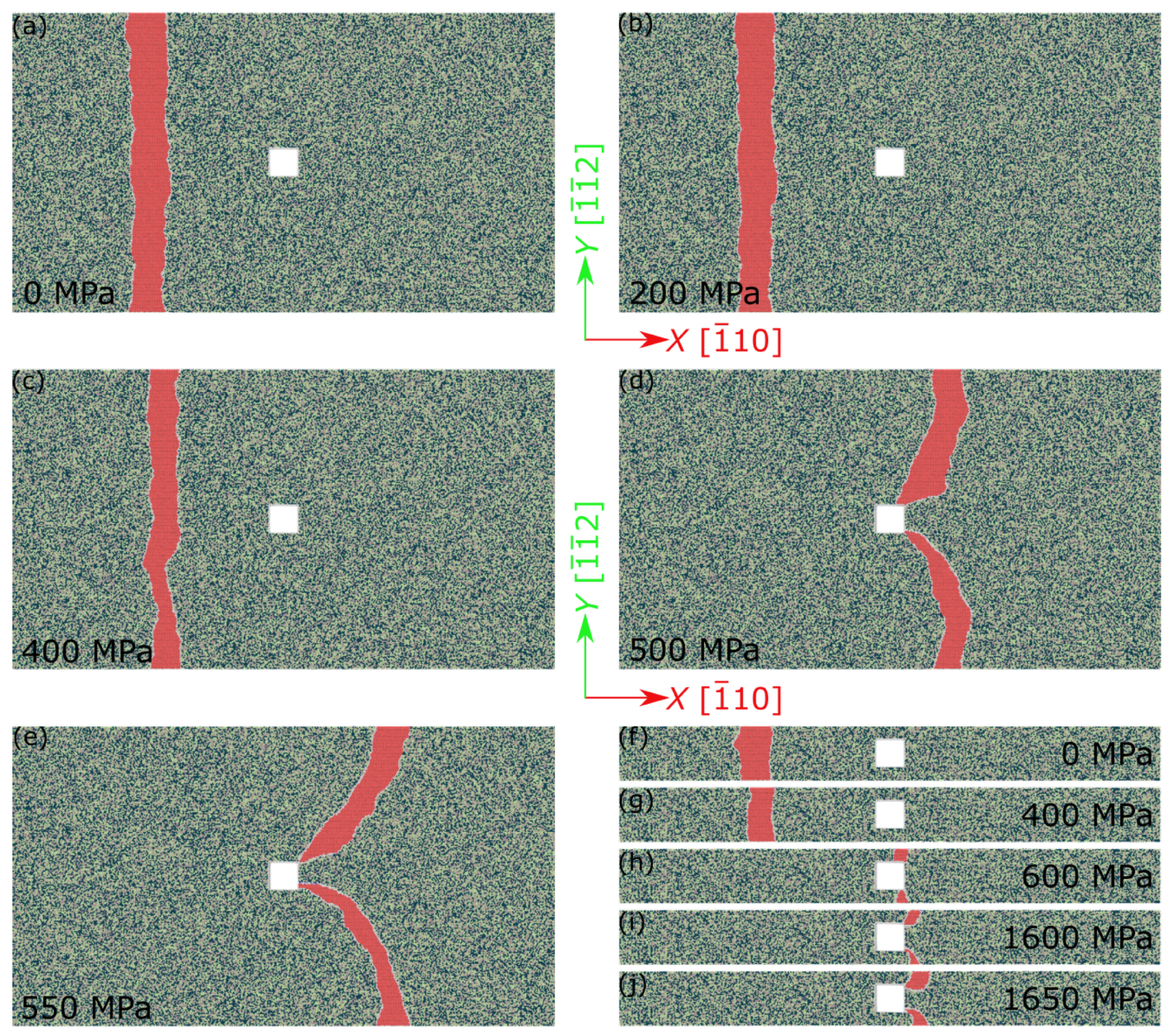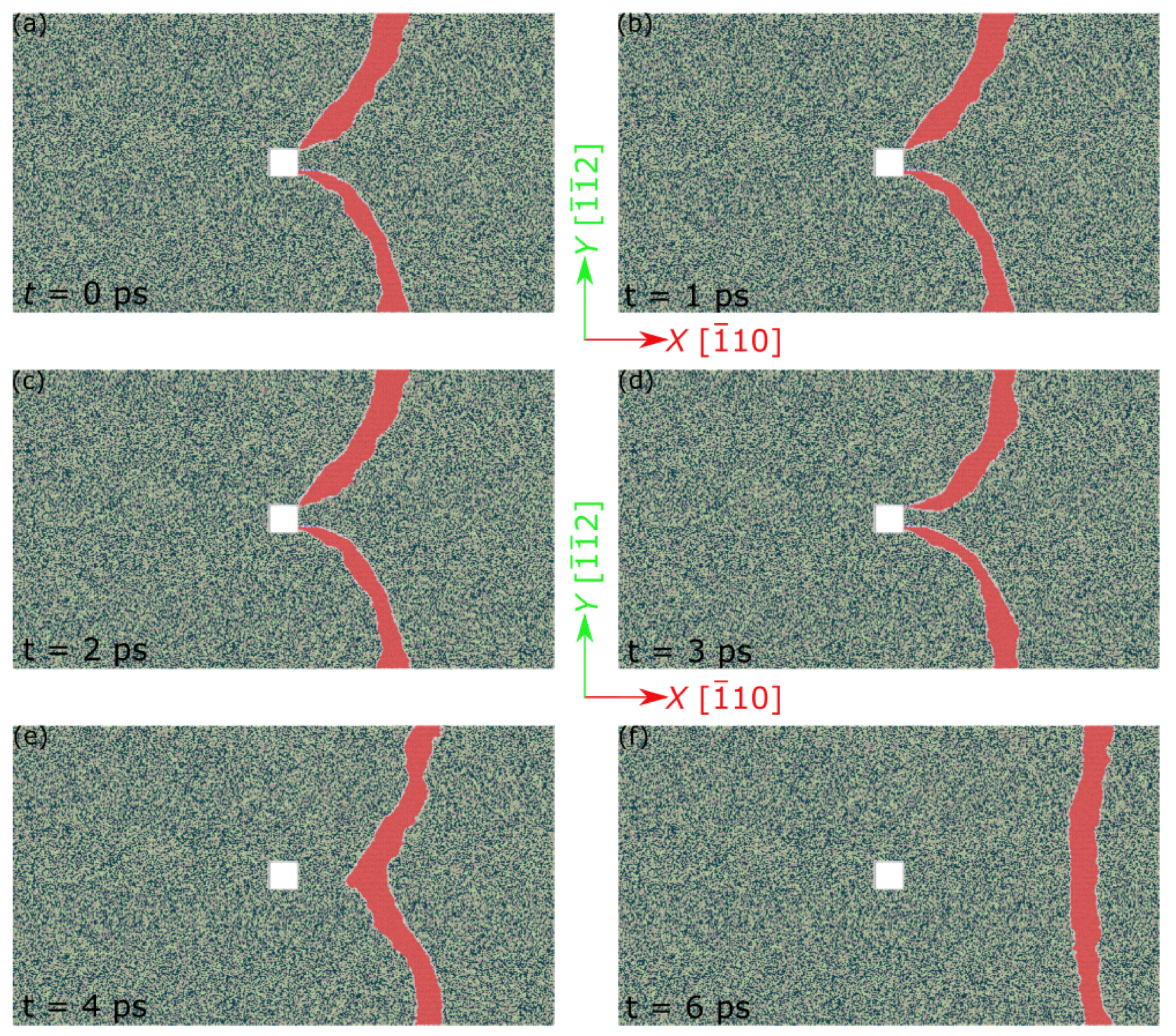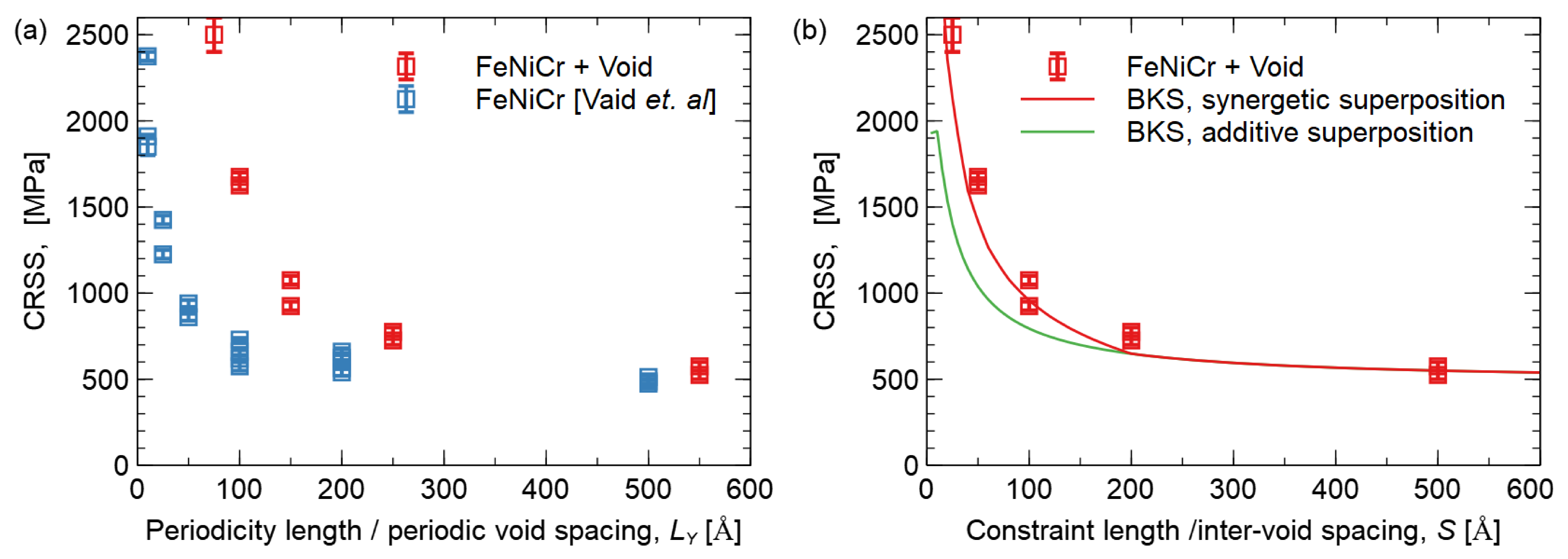Atomistic Simulations of Dislocation-Void Interactions in Concentrated Solid Solution Alloys
Abstract
:1. Introduction
2. Materials and Methods
3. Results and Discussion
4. Conclusions
Author Contributions
Funding
Data Availability Statement
Conflicts of Interest
Appendix A
| Parameter | Value |
|---|---|
| Lattice parameter, (Å) | 3.52 |
| (GPa) | 242.9 |
| (GPa) | 157.1 |
| (GPa) | 135.0 |
| (Average) stacking fault energy () | 60.5 |
References
- George, E.P.; Raabe, D.; Ritchie, R.O. High-entropy alloys. Nat. Rev. Mater. 2019, 4, 515–534. [Google Scholar] [CrossRef]
- Wang, X.; Mercier, D.; Danard, Y.; Rieger, T.; Perriere, L.; Laurent-Brocq, M.; Guillot, I.; Maurice, V.; Marcus, P. Enhanced passivity of Cr-Fe-Co-Ni-Mo multi-component single-phase face-centred cubic alloys: Design, production and corrosion behaviour. Corros. Sci. 2022, 200, 110233. [Google Scholar] [CrossRef]
- George, E.P.; Curtin, W.A.; Tasan, C.C. High entropy alloys: A focused review of mechanical properties and deformation mechanisms. Acta Mater. 2020, 188, 435–474. [Google Scholar] [CrossRef]
- Saha, J.; Saha, R.; Bhattacharjee, P.P. Microstructure and texture of severely warm-rolled and annealed coarse-grained CoCrNi medium entropy alloy (MEA): A perspective on the initial grain size effect. J. Alloys Compd. 2022, 904, 163954. [Google Scholar] [CrossRef]
- Ma, E. Unusual dislocation behavior in high-entropy alloys. Scr. Mater. 2020, 181, 127–133. [Google Scholar] [CrossRef]
- Basu, I.; Hosson, J.T.M.D. Strengthening mechanisms in high entropy alloys: Fundamental issues. Scr. Mater. 2020, 187, 148–156. [Google Scholar] [CrossRef]
- Inui, H.; Kishida, K.; Chen, Z. Recent Progress in Our Understanding of Phase Stability, Atomic Structures and Mechanical and Functional Properties of High-Entropy Alloys. Mater. Trans. 2022, 63, 394–401. [Google Scholar] [CrossRef]
- Gali, A.; George, E.P. Tensile properties of high- and medium-entropy alloys. Intermetallics 2013, 39, 74–78. [Google Scholar] [CrossRef]
- Dou, Y.K.; Cao, H.; He, X.F.; Gao, J.; Cao, J.L.; Yang, W. Interaction mechanism of an edge dislocation with a void in Fe-Ni-Cr concentrated solid-solution alloy. J. Alloys Compd. 2021, 857, 157556. [Google Scholar] [CrossRef]
- Qi, Y.; Chen, X.; Feng, M. Molecular dynamics-based analysis of the effect of voids and HCP-Phase inclusion on deformation of single-crystal CoCrFeMnNi high-entropy alloy. Mater. Sci. Eng. A 2020, 791, 139444. [Google Scholar] [CrossRef]
- Cawthorne, C.; Fulton, E.J. Voids in irradiated stainless steel. Nature 1967, 216, 5115. [Google Scholar] [CrossRef]
- Polfus, J.M.; Løvvik, O.M.; Bredesen, R.; Peters, T. Hydrogen induced vacancy clustering and void formation mechanisms at grain boundaries in palladium. Acta Mater. 2020, 195, 708–719. [Google Scholar] [CrossRef]
- Fan, Z.; Zhong, W.; Zhong, W.; Jin, K.; Ritchie, R.O.; Bei, H.; Osetsky, Y.; Osetsky, Y.N.; Zhang, Y. Diffusion-mediated chemical concentration variation and void evolution in ion-irradiated NiCoFeCr high-entropy alloy. J. Mater. Res. 2020, 36, 298–310. [Google Scholar] [CrossRef]
- Sui, H.; Yu, L.; Liu, W.; Liu, Y.; Cheng, Y.; Duan, H. Theoretical models of void nucleation and growth for ductile metals under dynamic loading: A review. Matter Radiat. Extrem. 2022, 7, 1. [Google Scholar] [CrossRef]
- Hull, D.; Bacon, D.J. Introduction to Dislocations; Butterworth-Heinemann: Oxford, UK, 2001. [Google Scholar]
- Haghighat, S.M.H.; Fivel, M.C.; Fikar, J.; Schaeublin, R. Dislocation-void interaction in Fe: A comparison between molecular dynamics and dislocation dynamics. J. Nucl. Mater. 2009, 386–388, 102–105. [Google Scholar] [CrossRef]
- Ganeyev, G.Z.; Turkebaev, T.E. The dislocation void interaction. Acta Metall. 1988, 36, 2. [Google Scholar] [CrossRef]
- Bitzek, E.; Gumbsch, P. Dynamic aspects of dislocation motion: Atomistic simulations. Mater. Sci. Eng. A 2005, 400–401, 40–44. [Google Scholar] [CrossRef]
- Jian, W.R.; Zhang, M.; Xu, S.; Beyerlein, I.J. Atomistic simulations of dynamics of an edge dislocation and its interaction with a void in copper: A comparative study. Model. Simul. Mat. Sci. Eng. 2020, 28, 4. [Google Scholar] [CrossRef]
- Cheng, Y.; Bitzek, E.; Weygand, D.; Gumbsch, P. Atomistic simulation of dislocation-void interactions under cyclic loading. Model. Simul. Mat. Sci. Eng. 2010, 18, 2. [Google Scholar] [CrossRef]
- Bacon, D.J.; Osetsky, Y.N.; Rodney, D. Chapter 88 dislocation–obstacle interactions at the atomic level. In Dislocations in Solids; Elsevier: Amsterdam, The Netherlands, 2009; pp. 1–90. [Google Scholar]
- Monnet, G. Mechanical and energetical analysis of molecular dynamics simulations of dislocation–defect interactions. Acta Mater. 2007, 55, 5081–5088. [Google Scholar] [CrossRef]
- Zou, Y. Nanomechanical studies of high-entropy alloys. J. Mater. Res. 2018, 33, 3035–3054. [Google Scholar] [CrossRef]
- Miracle, D.B. High-Entropy Alloys: A Current Evaluation of Founding Ideas and Core Effects and Exploring `Nonlinear Alloys. JOM 2017, 69, 2130–2136. [Google Scholar] [CrossRef]
- Vaid, A.; Wei, D.; Bitzek, E.; Nasiri, S.; Zaiser, M. Pinning of extended dislocations in atomically disordered crystals. Acta Mater. 2022, 236, 118095. [Google Scholar] [CrossRef]
- Plimpton, S. Fast Parallel Algorithms for Short-Range Molecular Dynamics. J. Comput. Phys. 1995, 117, 1–19. [Google Scholar] [CrossRef]
- Bonny, G.; Terentyev, D.; Pasianot, R.C.; Poncé, S.; Bakaev, A. Interatomic potential to study plasticity in stainless steels: The FeNiCr model alloy. Model. Simul. Mat. Sci. Eng. 2011, 19, 8. [Google Scholar] [CrossRef]
- Osetsky, Y.N.; Pharr, G.M.; Morris, J.R. Two modes of screw dislocation glide in fcc single-phase concentrated alloys. Acta Mater. 2019, 164, 741–748. [Google Scholar] [CrossRef]
- Varvenne, C.; Luque, A.; Curtin, W.A. Theory of strengthening in fcc high entropy alloys. Acta Mater. 2016, 118, 164–176. [Google Scholar] [CrossRef]
- Rodney, D. Molecular dynamics simulation of screw dislocations interacting with interstitial frank loops in a model FCC crystal. Acta Mater. 2004, 52, 3. [Google Scholar] [CrossRef]
- Guénolé, J.; Nöhring, W.G.; Vaid, A.; Houllé, F.; Xie, Z.; Prakash, A.; Bitzek, E. Assessment and optimization of the fast inertial relaxation engine (fire) for energy minimization in atomistic simulations and its implementation in LAMMPS. Comput. Mater. Sci. 2019, 175, 109584. [Google Scholar] [CrossRef]
- Stukowski, A. Visualization and analysis of atomistic simulation data with OVITO-the Open Visualization Tool. Model. Simul. Mat. Sci. Eng. 2010, 18, 15012. [Google Scholar] [CrossRef]
- Faken, D.; Jónsson, H. Systematic analysis of local atomic structure combined with 3D computer graphics. Comput. Mater. Sci. 1994, 2, 279–286. [Google Scholar] [CrossRef]
- Honeycutt, J.D.; Andemen, H.C. Molecular Dynamics Study of Melting and Freezing of Small Lennard- Jones Clusters. J. Phys. Chem. 1987, 91, 4950–4963. [Google Scholar] [CrossRef]
- Nasiri, S.; Zaiser, M. Effects of elasticity and dislocation core structure on the interaction of dislocations with embedded CNTs in aluminium: An atomistic simulation study. Materialia 2022, 21, 101347. [Google Scholar] [CrossRef]
- Scattergood, R.O.; Bacon, D.J. The Orowan mechanism in anisotropic crystals. Philos. Mag. 1975, 31, 179–198. [Google Scholar] [CrossRef]
- Bacon, D.J.; Kocks, U.F.; Scattergood, R.O. The effect of dislocation self-interaction on the orowan stress. Philos. Mag. 1973, 28, 1241–1263. [Google Scholar] [CrossRef]
- Hatano, T.; Kaneko, T.; Abe, Y.; Matsui, H. Void-induced cross slip of screw dislocations in fcc copper. Phys. Rev. B 2008, 77, 064108. [Google Scholar] [CrossRef]
- Foreman, A.J.E. Dislocation energies in anisotropic crystals. Acta Metall. 1955, 3, 4. [Google Scholar] [CrossRef]
- Zapperi, S.; Zaiser, M. Depinning of a dislocation: The influence of long-range interactions. Mater. Sci. Eng. A 2001, 309, 348–351. [Google Scholar] [CrossRef]
- Zaiser, M. Dislocation motion in a random solid solution. Philos. Mag. A 2002, 82, 2869–2883. [Google Scholar] [CrossRef]
- Zaiser, M.; Wu, R. Pinning of dislocations in disordered alloys: Effects of dislocation orientation. Mater. Theory 2022, 6, 4. [Google Scholar] [CrossRef]




Disclaimer/Publisher’s Note: The statements, opinions and data contained in all publications are solely those of the individual author(s) and contributor(s) and not of MDPI and/or the editor(s). MDPI and/or the editor(s) disclaim responsibility for any injury to people or property resulting from any ideas, methods, instructions or products referred to in the content. |
© 2023 by the authors. Licensee MDPI, Basel, Switzerland. This article is an open access article distributed under the terms and conditions of the Creative Commons Attribution (CC BY) license (https://creativecommons.org/licenses/by/4.0/).
Share and Cite
Vaid, A.; Zaiser, M.; Bitzek, E. Atomistic Simulations of Dislocation-Void Interactions in Concentrated Solid Solution Alloys. Metals 2023, 13, 1655. https://doi.org/10.3390/met13101655
Vaid A, Zaiser M, Bitzek E. Atomistic Simulations of Dislocation-Void Interactions in Concentrated Solid Solution Alloys. Metals. 2023; 13(10):1655. https://doi.org/10.3390/met13101655
Chicago/Turabian StyleVaid, Aviral, Michael Zaiser, and Erik Bitzek. 2023. "Atomistic Simulations of Dislocation-Void Interactions in Concentrated Solid Solution Alloys" Metals 13, no. 10: 1655. https://doi.org/10.3390/met13101655





